There’s no question that babies are adorable, from their chubby cheeks to their little stubby fingers. When you look at the rapid growth of your threemonth- old, you may even wish he could remain a baby just a little longer – if only that didn’t mean having to change his diapers for a longer time! This is just one thing that parents unanimously wish could be done earlier, if only to liberate them from the mess and monotony of changing diapers, not to mention the rising cost of disposable diapers.
When to begin potty training?
There is no ideal age for pottytraining. Certain cultures begin at a very early age, some as young as a few weeks after birth. For most people, particularly in the West, potty training usually starts when the child begins to show signs that she is ready. This may be anytime between 18 months and three years.
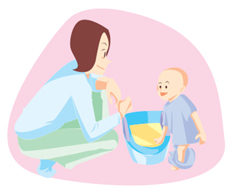
How can I tell if my baby is ready to be potty trained?
You can initiate potty training once he is able to sit on a potty. This can take place during bath time. If he is ready, he may want to sit on the potty until he produces some urine; conversely, he may only sit for a few seconds, or refuse to sit at all. If the latter happens, it would be wise to defer potty training to a later date.
Signs of readiness include:
- The ability to indicate that he has soiled his diapers. Generally, children learn to defaecate in a potty before urinating. It is also a big bonus if they are the sort who cannot tolerate bad smells and stuff in their diapers.
- A change in facial expression, particularly before opening their bowels. This allows you to sit her on the potty early.
- The ability to stay dry for several hours. This indicates improved bladder control and enables you to time potty breaks.
- The ability to indicate his needs either by vocalising or by pointing.
Potty training equipment
Compared with the huge number of things you needed for diaper changing, your needs for potty training are simple:
- Light, washable plastic potty. Check that there are no sharp bits, eg moulding marks, on the rim that could hurt baby.
- Toilet paper and paper towels
- Absorbent undersheet for mattress
- Water
- Plenty of patience
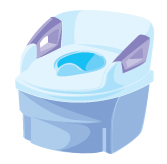
Part 1:
This Is A Potty
Before you show your child how and when to use the potty, you first have to introduce it to him. Let it become familiar to him by putting it in the bathroom and letting him “visit” it several times a day. Let him sit on it with his nappy and trousers on so he gets used to the feeling.
Part 2:
What You Do On the Potty
Tell him what the potty is for and encourage him to use it. Watch out for those signals that he may need to go, because it might not occur to him yet that he’s supposed to use a potty. Pay attention especially after meals, drinks and naps. Whenever he goes, help him to sit properly on it with his penis in to avoid misses.
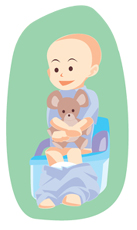
Part 3:
It’s OK To Make Mistakes
If he has accidents – which he will, at first – don’t yell at him or lecture him. He’s not doing this out of disobedience, he just hasn’t understood this new concept. Wipe up immediately, and tell him gently to use the potty next time. Be patient and repeat this as many times as it takes for him to remember. If you don’t want him to mess his briefs at this stage, but don’t want him to stay dependent on nappies, either buy absorbent, disposable briefs (like diapers with an elastic waistband) or let him go bare-bottomed. Obviously, you should choose the former if you have company over!
Part 4:
‘Now’ Doesn’t Necessarily Mean ‘Right Now’
If he happily sits down, but gets up quickly without having done anything, encourage him to sit a while longer. Five minutes should be enough time for you to discern whether he was stalling, or if he really doesn’t need to go. If he wants to get up and play, give him a toy or stay and talk to him so he isn’t bored. If after a few minutes nothing has happened, let him get up, and check in half an hour if he needs to use the potty.
Part 5:
When He Gets It Right
You’re obviously happy that he managed to do his business in the potty, so don’t keep the happiness to yourself. Praise him verbally, wipe him clean and send him back to his play with a hug and a smile. When he knows how much it means to you, he’ll be encouraged to keep it up.
| Things You Shouldn’t Say | Things You Should |
|
“You messed up the floor again? How many times do I have to tell you…” He doesn’t mean to have accidents, but they will happen. Instead of snapping at him, be matter-of-fact about it. “You just had to do it on the carpet, didn’t you?” Toddlers don’t understand sarcasm. If there are floor coverings or finishes that you want to protect, cover them with a big plastic sheet before letting your child play on them. “Yuck!” The more disgust you express at the contents of the potty, the more fascinating it becomes to him and the more he wants to examine it. |
“You didn’t get to the potty in time? Never mind, next time you’ll remember.” Show him that it’s no big deal, and demonstrate your confidence in him with “next time”. “Let’s play on the red mat.” Use the plastic sheet as a clear boundary of where he can play during this nappy-less stage. Call it a magic flying carpet, desert, spaceship or anything he fancies, and give him points for staying on it. “Away it goes!” You don’t exclaim about your own bodily wastes; you just flush them down. Do the same with your child’s. Show him how to flush and let him do it himself. Most children enjoy flushing, so make it an incentive for correct potty usage. “Show me how you drive a car.” Play-acting can take some of the stress out of sitting on a potty, and is all right so long as it doesn’t become the highlight of his day. Keep him entertained the rest of the time so that this isn’t all he has to look forward to. |
When It Doesn’t Work
You may find that your child just doesn’t get to the potty on time, or completely forgets what it’s for. In this case, it may be better to go back to diapers for another week or so before you try again.
Staying Dry At Night
When your child has been able to stay dry all day, and hasn’t wet his diaper at night for seven nights in a row, you can safely try leaving his diaper off at night. Some people advocate letting the child go to sleep wearing nothing below during this stage, so that he is conscious of the need to go to the potty to relieve himself. If this idea doesn’t catch your fancy, but you don’t want to have too big a mess to clean up, try using pull-up disposable diapers. These are a cross between underpants and nappies. They give him the dignity of wearing briefs like a grown-up, and the safety of diapers. Lastly, avoid comparing your child with other children, particularly in front of him. Children develop at different paces; with lots of patience and encouragement, he too will master the art of going without diapers.

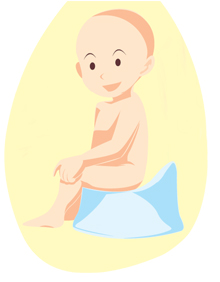

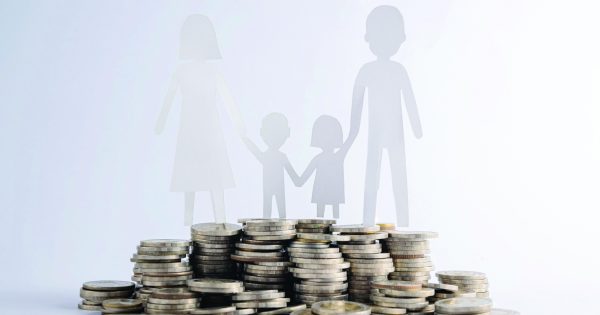

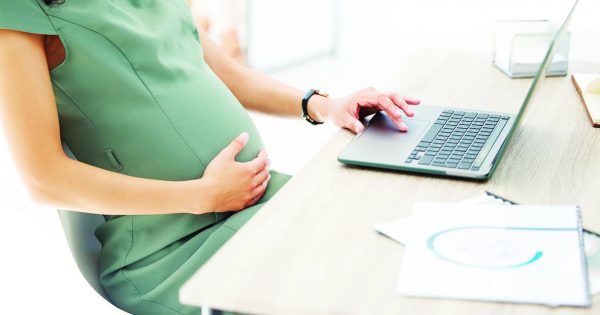

Comments